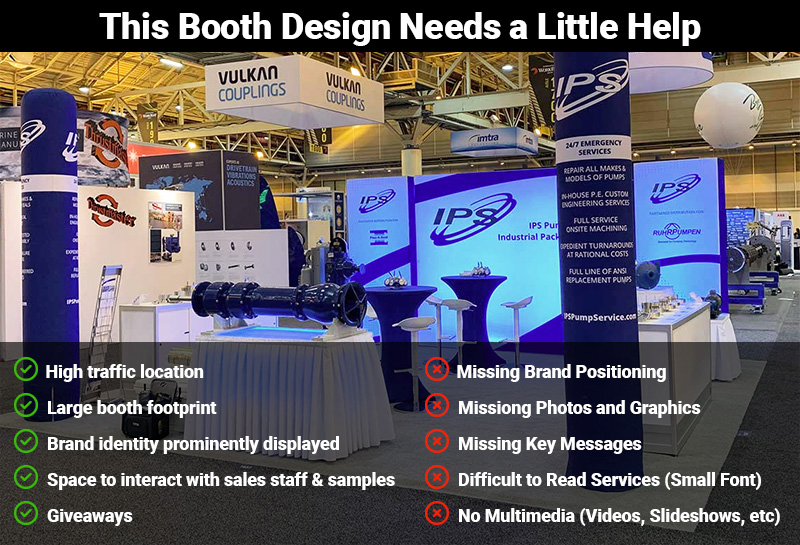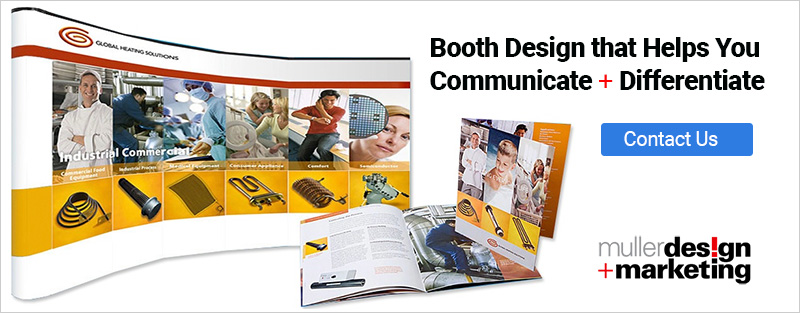Now that trade shows and in-person events are back in session, it’s important to make sure your investment pays off, and that you’ve maximized your time, budget and resources. Here’s a list of pre-show, during-show and post-show activities that will help make your next event successful in terms of ROI.
PRE-SHOW PLANNING
1. Create a strategy around your specific, measurable goals
Several weeks before the show, be clear why you’re attending, and what you want to achieve.
Your goals list may look something like this:
- Meet and talk to X number of people
- Meet specific decision makers and potential partners
- Demo your product to X number of people
- Attend X number of sessions
- Be a speaker
- Be a sponsor
Your strategy will then include activities and tactics to help you achieve each goal.
2. Define your budget and timeline
3. Select your booth location
Location plays a critical role in the success of your trade show experience. Review the exhibit hall layout and select a location in a high traffic area. You’ll pay more, but it will be worth it. Register early to avoid less-than-ideal booth locations.
4. Design your exhibit space and booth
Your booth is the first thing prospects will see so make sure the design:
- Is professional and simple with eye-catching graphics and messaging
- Incorporates compelling brand and key messages that address your prospects needs
- Includes large, readable text and website address
- Allows for prospects to enter your space to see product samples, marketing material, giveaways, etc.
5. Inform your network and prospects that you will be attending
Use email and social media posts to not only announce that you will attending, but include helpful information about the show and locale.
6. Setup meetings with current customers
Send out an announcement to all your current suppliers. Let them know you will be exhibiting and would like to see them there. Arranging meetings prior to the event is an excellent way to stay engaged and be able to showcase your full capabilities to your customers. Who knows, they may see something they had no idea you were able to do.
7. Speaking at an event
If you want to be a speaker, remember that conferences book them far in advance. Being a speaker provides instant credibility and a great opportunity to promote your company which in turn will drive more traffic to your booth. Your slide presentation can also be downloaded by attendees and used to nurture leads after the show.
8. Canvasing the exhibitors list for prospect customers
Blog articles allow you to showcase your insights and expertise on various topics, while also helping your site rank higher in the search engines. Organizations that blog have an average of 50% more visitors and 150% more leads than those who don’t. For ideas on what to write about, refer back to your target personas’ issues, needs, and challenges. To increase awareness, once your article is published, you can auto-post it to your social media channels, and use it as a landing page for your online advertising.
DURING-THE-SHOW
Your booth should be staffed with energetic and enthusiastic employees that connect with trade show attendees and are implementing the strategy you defined long before they arrived.
You’re there to work the booth, so sitting and working on a laptop or staring at a phone sends negative signals to prospects. Remember your goals—Let them drive you to meet and talk with as many people as possible.
1. Meet with partners and prospects
You should have a number of meetings set with current customers, but remember to leave space in your schedule for the prospects you mapped out prior to the show. Visiting them in their booth is a great starting point, however inviting them back to your booth will allow for a more engaging meeting and opportunity to showcase your company’s capabilities.
2. Attend sessions in order to meet decision makers and influencers
It’s tempting to skip sessions, but again the goal is to meet prospects and to learn as much as you can while you’re at the show.
3. Connect on a personal level
If at all possible, connect with your top customers and prospects on a personal level. Grab a coffee or lunch. Take your best customers out to dinner and get to know them. Why? Relationships matter & people buy from people they like and trust.
POST-SHOW
Keep the buzz going by generating post-trade show content on your blog and social media channels. And lastly, measure the results of your efforts according to the goals you set for the show and do so for several months after the show is over.
1. Follow up with attendees who visited your booth
Resist the urge to immediately sell these prospects. Instead simply thank them for stopping by and offer them a free download of your presentation in order to gauge their interest.
Setup a lead-nurturing campaign and send them relevant content that will help them address their needs. Lead with education before selling in order to build trust. This type of drip marketing will help keep you top of mind and help you identify who is interested in your products and services (those who unsubscribe were only interested in your giveaways).
Contact us for more information on how to create a lead nurturing email campaign.
2. Schedule a post-mortem with sales and marketing
Review your goals and strategy. Which did you achieve? Where did you fall short? What were the highlights? What can be improved? successes, failures, shortcomings, the good, the bad and the mediocre. The reality is that sometimes your best ideas may fall flat when put into practice or your team is forced to improvise or adjust for one reason or another. Post-mortem debriefs are helpful to identify any lessons learned and action items that need to be taken to improve the success of the next trade show.
3. Calculate the show’s ROI.
This will take some time as sales cycles can take weeks and months. But eventually you should have a good side-by-side comparison of your expenses and the sales that resulted from attending the show. One thing that is hard to quantify is brand awareness, so even if you fell short on your leads and sales goals, there is some inherent value in attending.
4. Schedule follow up meetings with prospects
The name of the game is follow up. You will be tempted to stop reaching out after the prospects you met shun your email and voicemail requests to meet after the show. This is a very typical response to noncommunication, however don’t stop following up until someone tells you to stop. They are busy themselves following up and will eventually set the meeting if you are professional and persistent enough.
If you need assistance with your next trade show strategy or booth design, contact us, and we can schedule a time to discuss your needs. We’re here to help!



